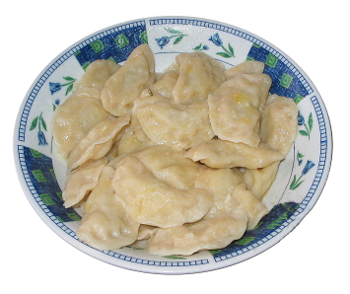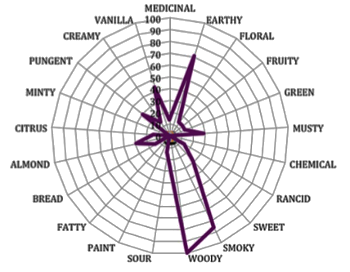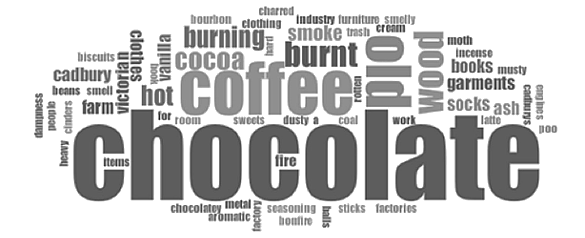The Scent of Books
May 22, 2017
The human
sense of smell is not as acute as it is in many
animals, but it does serve some useful purposes. We're able to distinguish between good
food and food that's
spoiled or not that
nutritious. Animals use smell as an aid in finding a
mate through detection of the complex
chemical vapors called
pheromones they emit to signal their presence.
Since
human pheromone emission is much more subtle, we augment our
aura with
perfume and
cologne. These seem to work well, since most
men will admit that the scent of a certain perfume will bring back
memories of a
girlfriend. The senses of
taste and smell are intimately linked, since
olfaction is an important supplement to the tongue's primitive
taste receptors.
The prime example of taste evoking memory is contained in
Marcel Proust's novel, "
À la recherche du temps perdu," a title that's commonly translated as "Remembrance of Things Past." This is a considerable work that's three thousand pages long and contained in seven volumes. It's understandable that Proust had a hard time finding a
publisher for this work, and he
self-published the first volume.
There's a
scene in Proust's novel known as the "episode of the
madeleine" in which the taste of a
cake triggers a childhood memory. The scent of
pierogi brings to my mind memories of my
maternal grandmother, but I haven't yet started writing my seven volumes.

A plate of potato pierogi, just like babcia used to make.
(Modified Wikimedia Commons image by Kagor.)
Virtual reality is making inroads into
entertainment, but an early leap into virtual reality was provided by
Smell-O-Vision. This
technology,
patented by Hans Laube in 1959,[1]
synchronized odors with scenes in a
film. Alas, the technology was ahead of its time, so it was
ridiculed in the
media, being named as one of the "Top 100 Worst Ideas of All Time," along with
New Coke,
spray cheese, and the
programming decision that led to the
Y2K bug.

Smell-O-Vision was based on odor-containing cells selected by a simple reel-to-reel transport system. Today, it would be very easy to make a personal odor delivery system for virtual reality systems using thick film technology with resistive heating elements. (Portion of fig. 1 from US Patent No. 2,905,049, "Motion pictures with synchronized odor emission," by Hans Laube, September 22, 1959.[1]
One odor I haven't experienced in quite a while is the smell of
books in a
library. I haven't been inside a library in years, since all my reading materials are obtained from
online shopping, or through the
Internet. If I ever again venture into a library, I'm sure the smell will be that of
carpets and
computers, not the smell of old books, and those smells would not evoke
childhood memories.
A recent study by
Cecilia Bembibre and
Matija Strlič at the
University College London Institute for Sustainable Heritage has quantified the nature of "book smell."[3-4] Their results are
published in an
open access article in the
journal,
Heritage Science.[3] The study
authors point out that odors are important in our lives, but we have little knowledge of the smells of the past. They argue that smells are part of our
cultural heritage, so they should be identified and
conserved.[3]
As a start, they did a study in which they collected library
visitor impressions of book odor.[3]
chemical analysis was also undertaken of the
volatile organic compounds emitted from historic books.[3] Says study
coauthor, Cecilia Bembibre, "The role of smells in how we perceive heritage has not been systematically explored until now."[4]
In a first study, visitors to
St Paul's Cathedral's Dean and Chapter library,
London, were asked to characterize its smell.[4] All visitors described the library's aroma as
woody, followed by
smoky (86%),
earthy (71%) and
vanilla (41%). More than 70% of the visitors described the smell as pleasant.[4]

Old books are "woody," followed by "smoky," and "earthy."
A graphical exposition of how study participants perceived the smell of old books.
(Portion of fig. 3 of ref. 3, licensed under the Creative Commons Attribution 4.0 International License.[3]
In another
experiment, visitors to the
Birmingham Museum and Art Gallery were presented with the smell of an unlabeled 1928 book obtained from a
second-hand bookshop in London. The words used to describe the smell were collected, and terms related to
chocolate were used most often used, followed by
coffee,
old,
wood and
burnt (see figure).[4] Other terms included
fish,
body odor,
rotten socks and
mothballs.[4]

Word cloud of terms used to describe an old book. (Portion of fig. 2 of ref. 3, licensed under the Creative Commons Attribution 4.0 International License.[3] Click for larger version.)
The
researchers did a chemical analysis of volatile organic compounds sampled from books in the Dean and Chapter library. They were able to catalog the major
chemicals present in "book smell," as listed in the following table. These were obtained using a technique called
solid phase microextraction and
gas chromatography-mass spectrometry (SPME–GC–MS}.[4]
| | Compound | Aroma descriptor |
| | Acetic acid | Sour |
| | Propanoic acid | Pungent, rancid, soy |
| | 2,4-Dimethylheptane | Gasoline-like |
| | Toluene | Paint |
| | Hexanal | Grass, tallow, fat |
| | Nonane | Alkane |
| | Furfural | Bread, almond, sweet |
| | Heptanal | Fat, citrus, rancid |
| | Undecane | Alkane |
| | Dodecane | Alkane |
| | Benzaldehyde | Almond, burnt sugar |
| | d-Limonene | Lemon, orange |
| | Nonanal | Fat, citrus, green |
| | Undecanal | Oil, pungent, sweet |
| | Icosane | Alkane |
The authors suggest that the method could be used as a
diagnostic tool to assess the condition of an object through its olfactory profile.[4] Odors can be used to enhance visitor experience in
museums by understanding what the past smelled like.[4]
References:
- Hans Laube, "Motion pictures with synchronized odor emission," US Patent No. 2,905,049, September 22, 1959.
- 100 Worst Ideas Of The Century, anvari.org.
- Cecilia Bembibre and Matija Strlič, "Smell of heritage: a framework for the identification, analysis and archival of historic odours," Heritage Science, vol. 5, no. 2 (April 7, 2017), DOI: 10.1186/s40494-016-0114-1. This is an open access article with a PDF file available at the same link.
- 'What do old books smell like?' -- Preserving smells as important cultural heritage, BioMed Central Press Release, April 6, 2017.
Permanent Link to this article
Linked Keywords: Sense; smell; sense of smell; animal; food; food spoilage; spoiled; nutrition; nutritious; mating; mate; chemical compound; vapor; pheromone; human body odor; human pheromone emission; aura; perfume; eau de Cologne; cologne; man; men; long-term memory; girlfriend; taste; olfaction; taste receptor; Marcel Proust; novel; À la recherche du temps perdu; publishing; publisher; self-publishing; self-published; plot (narrative); scene; madeleine; cake; pierogi; grandparent; maternal grandmother; potato pierogi; babcia; Wikimedia Commons; Kagor; virtual reality; entertainment; Smell-O-Vision; technology; patent; patented; synchronization; synchronized; film; ridiculous; ridiculed; mass media; New Coke; spray cheese; computer programming; Year 2000 problem; Y2K bug; roll-to-roll processing; reel-to-reel transport system; thick film technology; Joule heating; resistive heating element; US Patent No. 2,905,049, "Motion pictures with synchronized odor emission," by Hans Laube, September 22, 1959; book; library; online shopping; Internet; carpet; computer; childhood; Cecilia Bembibre; Matija Strlič; University College London; Institute for Sustainable Heritage; scientific literature; open-access journal; open access article; Heritage Science; author; cultural heritage; conservation-restoration of cultural heritage; visitor; analytical chemistry; chemical analysis; volatile organic compound; coauthor; St Paul's Cathedral; Dean and Chapter library; London; wood; woody; smoke; smoky; soil; earthy; vanilla; radar chart; graphical exposition; Creative Commons Attribution 4.0 International License; experiment; Birmingham Museum and Art Gallery; used bookstore; second-hand bookshop; chocolate; coffee; combustion; burnt; fish; body odor; decomposition; rotten; sock; mothball; tag cloud; Word cloud; research; researcher; solid phase microextraction; gas chromatography-mass spectrometry; acetic acid; sour; propanoic acid; pungent; rancid; soy; heptane; 2,4-Dimethylheptane; gasoline-like; toluene; paint; hexana; grass; tallow; fat; nonane; alkane; furfural; bread; almond; sweet; heptanal; citrus; undecane; dodecane; benzaldehyde; sugar; d-Limonene; lemon; orange (fruit); nonanal; leaf vegetable; green; undecanal; oil; icosane; diagnosis; diagnostic; museum.